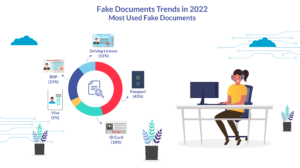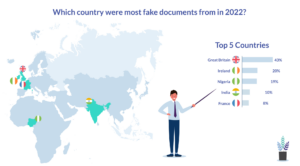Trends in Fraudulent Identity Documents in 2022

In a survey which we carried out at the end of 2022, 42% of people who responded thought it was likely that a candidate could present a fake proof of identity for a Right to Work check but only one third of respondents were very confident that they would be able to identify a fake document.
Identifying a fake document isn’t always easy and the techniques deployed by fraudsters are constantly evolving. As we perform thousands of identity document verification checks for our customers every week, we detect and record a wide range of fake identity documents.
To give you an insight into the sort of fraudulent documents we saw in 2022, we have put together our annual statistics, collating data from all of our Right to Work (RtW), Right to Rent (RtR), and Know Your Customer (KYC) document checks. We’ve drawn out some of the most important insights and our experts share their views on what the trends might mean for you, as well as tips on what to look out for.
What were the most common forms of fake documents in 2022?
In 2022, passports remained the most common fake document seen by our customers – the same as our previous 2 years’ analysis. They made up 45% of the total of all fake documents we saw in 2022. This is up 6% on last year’s figure.

At the same time, there has been a major drop in the number of fraudulent ID cards presented in 2022 with ID cards making up only 18% of all fake documents. This decline reflects the ongoing trend: in 2020, fraudulent ID cards almost equalled passports with 39% of the total and in 2021, they made up 29%. As EU ID cards no longer prove eligibility for Right to Work in the UK, applicants may have switched to providing fraudulent Sharecodes or other fraudulent documents instead.
Matt Green-Armytage, Operations Director says,
“You might believe that it’s easier to spot a fake passport due to your familiarity with them; you’ve probably seen lots, so you think you’re more likely to be able to spot a fake. On the other hand, because they’re so familiar, you may scrutinise them less and actually be at higher risk of accepting a fraudulent document.”
Of course, it’s important to remember that you must not discriminate against any candidate. And HR and onboarding teams should afford the same level of scrutiny to all documents, regardless of their perceived familiarity with them.
Which country were most fake documents from in 2022?
Once again, throughout 2022 we saw fraudulent identity documents from a huge range of countries. However, the fraudulent identity document which our customers saw most often was a British passport. From all of the fake documents we detected last year, over half (55%) were British.
In 2020 and 2021, France led the league table however. This seismic shift can be explained by the fact that European documents no longer give workers or renters the same rights and access in the UK. The initial move into fraudulent Biometric Residence Cards (BRPs) in 2022 has now also declined as BRPs were removed from the list of eligible Right to Work documents in April 2022. Fraudsters now have limited viable options and are therefore forced to present UK and Irish documents, or an eVisa, to prove their Right to Work or Right to Rent status.

Irish documents have also seen a huge increase in 2022, taking them to the second most commonly seen fraudulent document. In 2021, only 4% of fake documents seen by our customers were Irish and just a few years ago, the TrustID customer base rarely saw a fake Irish document. In particular, our customers have seen a significant increase in fraudulent Irish passport cards, which holders can present online through the digital Schemes and, if accepted, would give them indefinite Right to Rent or Right to Work with no restrictions.
Christie Lewis, Head of the Identity Document Team at TrustID adds, “The number of fraudulent British and Irish documents presented to our customers has grown significantly this year. Their holders know that, if their identity check is successful, they can gain work or rent a property without needing a follow-up check in the future.”
Which sectors were most targeted by identity fraud in 2022?
In 2022, the sector that encountered the greatest number of fraudulent documents was medical recruitment. 17% of all fakes seen across our customer base were from those recruiting medical staff. Two years ago, that figure was 9%, and in 2021 13%. Medical recruiters should look out for passports and biometric residence permits, as they make up a staggering 42% and 37% of all the fakes seen in 2022 by our customers in that sector.

Understaffing in the medical sector may have led to fraudsters trying to capitalise on a potential opportunity, believing that recruiters who need to quickly fill roles may not pay as much attention when checking identity documents. In this sector, getting checks right is critical to protect patients and staff, so using an IDSP can be an efficient and reliable way to ensure that you are only employing legitimate candidates.
While medical recruitment rose from third to first place, construction recruitment fell from first to third; the pair effectively swapping places. Construction recruiters still see a high number of fake documents though – 13% of all fraudulent documents in 2022. However, this has dropped from 25% in 2021 and 38% in 2020.
The biggest standouts from 2022 and what to be aware of in 2023
2022 has seen a shift towards British and Irish documents. These documents are sophisticated, secure, and full of security features. But the fraudsters perhaps believe that they will be seen as a familiar and trusted document and less likely to be thoroughly scrutinised. Of course, successfully presenting these documents would also give the holder an unlimited right to access services in the UK, including work and property.
Whilst guidance for employers and landlords continues to evolve and change, British and Irish documents remain a constant and so there will never be a need for a successful applicant to be checked again.
That said, at TrustID, we have also seen many cases of fraudsters changing their approach to meet the latest guidance, with the document they present to different potential employers changing. For example, an applicant attempting to gain employment using a fraudulent Spanish document in 2020 and then moving to present a fake BRP in 2021. When BRPs no longer gave eligibility in 2022, they presented instead a fraudulently obtained Sharecode.
In 2023, as online identity checks become increasingly prevalent, it’s important to watch out not only for fraudulent documents, but also for genuine documents presented by imposters. Whether you are checking physical documents or using online options, you must make sure that your applicant matches the person presenting the document. You can either do this face-to-face or using a secure video link. Identity validation services can also help thanks to liveness and face matching technology, which analyses a selfie photo against the image of your applicant.
Want to find out more?
Our analysis shows that the types of documents and sectors targeted by fraudsters continue to evolve and so it’s best to get help from a qualified expert. As a government-certified IDSP, we are experts in identity documents.
Get in touch to learn more about our document checking services or arrange a demo.
Sign up to receive updates
Receive notifications from TrustID direct to your inbox. Simply fill out your email address in the form below.
Want to find out more?
We’d be really happy to chat through your requirements and offer advice on the best service for your business.
Tel: 0118 466 0822 or email us.
Request a callback


